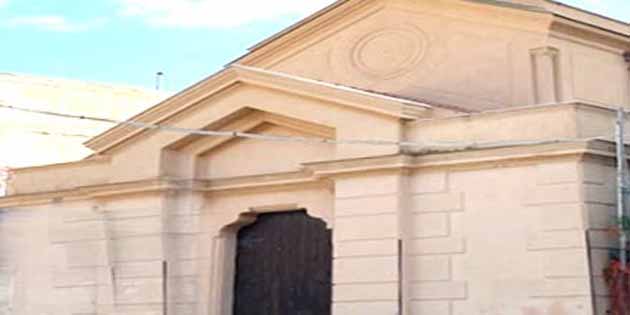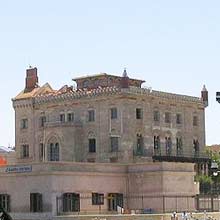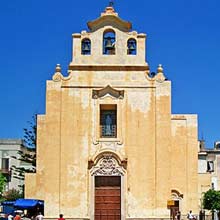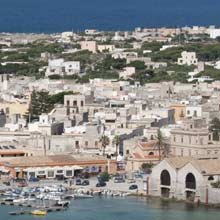Church of Sant'Antonio da Padova in Favignana

The Church of Sant'Antonio da Padova in Favignana is located in Largo Marina, the area that forms the boundary of the Camparia complex.
The church was built at the end of the nineteenth century at the behest of the family Florio, who had the trap and the tuna processing plant here and were the owners of the entire archipelago. It was a church for the employees of the plant. The project of the church was entrusted to the architect Giuseppe Damiani Almeyda who also took care of renovating and expanding the Tonnara plant.
The main façade of the church overlooking Piazza Europa has a wooden entrance portal, decorated with a solid outline in bronze alloy and defined on the sides by two corner columns on a pedestal characterized by a smooth shaft and Corinthian capital. The tympanum that overlooks it is marked by a mighty frame which, running uninterruptedly along the entire perimeter of the building, crowns all the architectural elements present. Visually, a thin dark gray vein stands out which contrasts with the pinkish orange of the external plaster worked in ashlar and for the part of the bell tower, in false bricks. The bell tower in the shape of a turret stands out on via Albanese rising for 13.60 meters, in the belfry there is a bronze bell dated 1898.
The interior of the church has a basilica-type plan with three naves, in the back wall an apse not preceded by a transept houses the marble altar with geometric panels and the statue of Sant'Antonio, from which the church takes its name. The columns that support the weight of the lateral arches between the naves rest on the ground by means of a pedestal, have a Corinthian capital of which the acanthus leaves are the part that stands out most visually. The entrance vestibule is a rectangular room with two niches on the sides, it seems to have the same characteristics of the classic "narthex": a vestibule outside the Byzantine basilicas where catechumens and penitents remained in the first centuries of Christianity. The space that separates from the vestibule is dominated by a painted lunette depicting Saint Anthony in a blessing act immersed in a coastal landscape. The church's frescoes, beautiful tempera paintings with figures of angels, are a splendid example of Art Nouveau .


